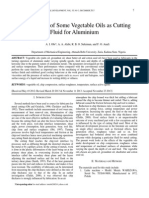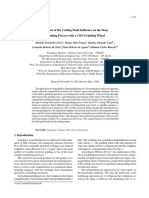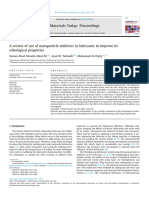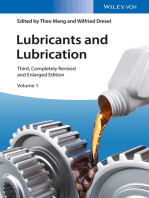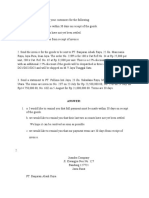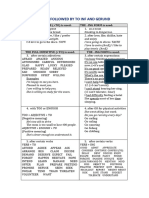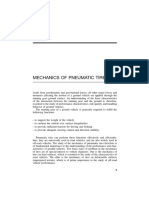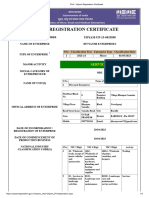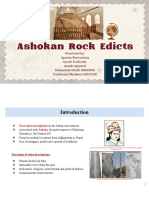Journal of Material Science and Mechanical Engineering (JMSME) Print ISSN: 2393-9095; Online ISSN: 2393-9109; Volume 2, Number 9; April-June, 2015 pp. 1-5 © Krishi Sanskriti Publications http://www.krishisanskriti.org/jmsme.html
Vegetable Oil Based Cutting Fluids–Green and Sustainable Machining - I
Papiya Bhowmik
1
, Ujjwal Kumar
2
and Gaurav Arora
3
1
School of Engineering and Technology, Sharda University, Greater Noida, U.P
2
P. G. Students, School of Engineering and Technology, Sharda University, Greater Noida, U.P E-mail:
1
papiya.bhowmik@sharda.ac.in,
2
ujjwal74@gmail.com,
3
gaurav.arora@sharda.ac.in
Abstract—
Comfortable and healthy workplaces are important for sustainable machining. Sustainable machining should be reliable and consistent. Green machining means environment friendly and hazard free, this is somehow achieved by the machining with Vegetable oil Based Cutting Fluids (VBCFs). Unfortunately, Metal Working Fluids also have several negative health, production cost, and environmental impacts. This paper focuses on an experimental investigation into the role of green machining on surface Roughness (Ra), in the machining of aluminium AA1050. A comparative study of turning experiments, between VBCFs and MBCFs under various cutting conditions, using neat or straight Sunflower oil and Coconut oil, was conducted using the same machining parameter set-up. Vegetable oils used on the principle of Minimum Quantity Lubrication (MQL) that is oil dropped between the cutting tool and workpiece interface directly. The results show that vegetable oil performance is comparable to that of mineral oil machining. The results show that Vegetable oils have potential to replace the mineral oils.
Keywords
: Aluminium AA1050, Vegetable oil Based Cutting Fluids (VBCFs), Mineral oil Based Cutting Fluid (MBCFs), Minimum Quantity Lubrication (MQL), Surface roughness (Ra).
1.
INTRODUCTION
A Metal Cutting Fluids (MCFs) is a substance used to facilitate relative motion of solid bodies by minimizing friction and wear between interacting surfaces. Metal working fluids (MCFs), otherwise known as cutting fluids come under lubricants which are extensively used in machining operations [1, 2]. During metal cutting operation, the material that is removed from the work piece slides along the rake face of the cutting tool in the form of continuous or discontinuous chips, resulting in friction. Cutting fluids affect the productivity of machining operations, tool life, and quality of work piece and prevent the cutting tool and machine from overheating as well [3, 4]. According to chemical formulations, cutting fluids are classified into four categories: straight (neat) cutting oils, soluble oils (emulsified oils, emulsions), synthetic (chemical) fluids, semi-synthetic (semi-chemical) fluids [5, 6, 7]. Mineral, synthetic and semi-synthetic CFs involve in the ecological cycle with air, soil and water and their toxicity effect damages the ecosystem. They cause serious health problems such as lung cancer, respiratory disease, dermatological and genetic disease [8]. Reports indicate that in 2005, 38 million metric tons and in 2009, 39 million tons of lubricants had been used in machine tools around the planet with a projected increase of 1.2% over the next decade, out of this amount 85% is of petroleum-based oils [9]. To overcome these, demand for biodegradable cutting fluids has increased with the use of vegetable based cutting fluids as an alternative to mineral based cutting fluids. VBCFs are environmentally friendly, renewable, less toxic and they reduce the waste treatment costs due to their inherently higher biodegradability [8, 9]. Vegetable oil-based MWFs can be used in the same operations as mineral based, or petroleum-based, fluids. One reason vegetable oil performs better is its lubricity. Another reason vegetable oil performs better than mineral oil is that it has a higher flash point, which reduces smoke formation and the risk of fire. A third reason vegetable oil performs better is that it has a high natural viscosity [10]. VBCFs, minimum quantity lubrications (MQL) have a higher potential of use under these limitations. In MQL machining, a small amount of vegetable oil is dropped to the tool and workpiece interface. MQL technique is used in experiment which is an alternative developed towards the “green machining”. It refers to total use, without residue, applying lubricant between 50-500ml/h [11, 12, 13, 14]. When cleaning vegetable oil, the same filtration systems and waste treatment processes used for mineral oil will work. “In most of the cases, you will not have to modify your operation or equipment to use vegetable oil”. The environmental and toxicity issues provided a new research interest in the use of vegetable oils, such as soybean oil, canola oil, sunflower oil, coconut oil, sesame oil, castor oil, jatropha oil, cottonseed oil, palm oil etc. as environmentally friendly lubricants and industrial fluids [15, 16, 17, 18, 19].

Papiya Bhowmik, Ujjwal Kumar and Gaurav Arora Journal of Material Science and Mechanical Engineering (JMSME) Print ISSN: 2393-9095; Online ISSN: 2393-9109; Volume 2, Number 9; April-June, 2015 2 The purpose of this research work is to evaluate the surface finish by applying neat vegetable oil with their inherent properties and compare with water soluble mineral oil under different cutting parameters like spindle speed, depth of cut and feed rate.
2.
MATERIAL AND METHODOLOGY
In this experimental study, machining process was conducted using a SIEMENS MTAB FLEXTURN CNC turning machine
maximum speed of 4000 rpm and 415V AC drive motor. The workpiece material used was Aluminium alloy (AA1050) cylindrical rod. This study included 39 pieces of cylindrical aluminium specimens with a 60 mm length and 30 mm diameter.
Table 1: Chemical Composition of AA1050 (Wt %)
Mn Fe Cu Mg 0.05 0.40 0.05 0.05 Si Zn Ti Al 0.25 0.07 0.05 99.08
Fig. 1: Aluminium Specimen
The cutting tool inserts used were tungsten carbide single point cutting tool. The machining experimental setup is shown in Fig. 1.
Fig. 2: Schematic experimental turning setup
Machining performance was assessed based on the surface roughness of the machined surfaces. Surface roughness was chosen as output parameters for evaluation using the two vegetable oil-based cutting fluids and mineral oil-based cutting fluids. VBCFs, was used as minimum quantity lubrication (MQL) i.e. at tool-workpiece interface. An overhead system was used to drop the vegetable oil-based cutting fluids between the tool-workpiece interfaces. The mineral oil-based cutting fluid was applied using conventional (flood) method. The mineral oil-based cutting fluids, water to oil ratio of 20:1. The new cutting fluid i.e. VBCFs (Sunflower and Coconut) used neat and straight with their inherent properties. Both oils are from edible category.
Table 2: Physico-Chemical Properties of Vegetable oils and Mineral oil Properties Sunflower Coconut Mineral (WS)
Kinematic viscosity at 40°C 40.05 36.2 29.55 Kinematic viscosity at 100°C 08.65 6.76 5.38 Viscosity index 206 130 116 Flash point (0°C) 252 240 150 Pour point (0°C) -12.00 20.00 -09.00
The surface roughness of the workpiece was measured at three different points along the length of the cut bar using stylus type surface roughness tester MITUTOYO (SURFTEST SJ - 210) Fig. 2. During the turning operations, all cutting experiments were stopped after every 35 mm machining length, in order to measure surface roughness (Ra).
Fig. 3: Surf Test (MITUTOYO SJ-210)
Some Specification of surface roughness tester are: Working Principle is Root Mean Square value, Measuring Force – 4mN, Stylus Profile – Tip Radius: 5
μ
m, Tip Angle: 90
0
, Testing Range – 360
0
μ
m (-200
μ
m to +160
μ
m ). Types of cutting fluid, spindle speed, depth of cut and feed rate are considered as longitudinal turning parameters. The range of turning parameters are selected as recommended from the machine manufacturer. Three sets of cutting parameters were employed during the machining process. The work pieces machined with varying spindle speed i.e. 1200-2000 rpm, with varying feed rate of 110-150 mm/min and depth of cut between 0.1-0.5 mm.
The process of turning has been done in the following three cases:
Vegetable Oil Based Cutting Fluids–Green and Sustainable Machining - I
3
Journal of Material Science and Mechanical Engineering (JMSME) Print ISSN: 2393-9095; Online ISSN: 2393-9109; Volume 2, Number 9; April-June, 2015
Varying Spindle Speed while keeping the Depth of Cut and Feed Rate constant.
Varying Feed Rate and keeping the Spindle Speed and Depth of Cut constant.
Varying Depth of Cut while keeping the Spindle Speed and Feed Rate constant.
3.
RESULTS AND DISCUSSION
In order to evaluate the machining process performance, surface roughness were compared under various cutting conditions to conventional oil and vegetable oil-based cutting fluids. In an effort to specify performances of CFs, root mean square value of the surface roughness for each CFs was analyzed.
In most of the cutting conditions, values of surface roughness obtained from the vegetable oil based cutting fluid machined samples are better, equivalent or nearer to the results obtained from the samples machined by conventional cutting oil. Various chips produced in turning: (a) tightly curled chip; (b) chip hits workpiece and breaks; (c) continuous chips moving away from the workpiece; (d) chip hits tool shank and breaks off; and (e) discontinuous chips. A.
All the results are described in the below given tables (3-5) (Sunflower oil/Edible oil).
Table 3: “Ra” Values for Varying Spindle Speed S. No. Spindle Speed (N) (Rev./min) Depth of Cut (d) (mm) Feed Rate (V) (mm/min) Ra Value (
μ
m)
1. 1200 0.2 120 0.90 2. 1400 0.2 120 0.81 3. 1600 0.2 120 0.56 4. 1800 0.2 120 0.55 5. 2000 0.2 120 0.54
Table 4: “Ra” Values for Varying Depth of Cut S. No. Spindle Speed (N) (Rev./min) Depth of Cut (d) (mm) Feed Rate (V) (mm/min) Ra Value (
μ
m)
1. 1600 0.1 120 0.53 2. 1600 0.2 120 0.56 3. 1600 0.3 120 0.56 4. 1600 0.4 120 0.52 5. 1600 0.5 120 0.54
Table 5: “Ra” Values for Varying Feed Rate S. No. Spindle Speed (N) (Rev./min) Depth of Cut (d) (mm) Feed Rate (V) (mm/min) Ra Value (
μ
m)
1. 1600 0.2 110 0.57 2. 1600 0.2 120 0.56 3. 1600 0.2 130 0.74 4. 1600 0.2 140 0.72 5. 1600 0.2 150 0.79
B.
All the results are described in the below given tables (6-8) (Coconut oil/Edible oil).
Table 6: “Ra” Values for Varying Spindle Speed S. No. Spindle Speed (N) (Rev./min) Depth of Cut (d) (mm) Feed Rate (V) (mm/min) Ra Value (
μ
m)
1. 1200 0.2 120 0.89 2. 1400 0.2 120 0.75 3. 1600 0.2 120 0.55 4. 1800 0.2 120 0.51 5. 2000 0.2 120 0.45
Table 7: “Ra” Values for Varying Depth of Cut S. No. Spindle Speed (N) (Rev./min) Depth of Cut (d) (mm) Feed Rate (V) (mm/min) Ra Value (
μ
m)
1. 1600 0.1 120 0.58 2. 1600 0.2 120 0.55 3. 1600 0.3 120 0.48 4. 1600 0.4 120 0.54 5. 1600 0.5 120 0.60
Table 8: “Ra” Values for Varying Feed Rate S. No. Spindle Speed (N) (Rev./min) Depth of Cut (d) (mm) Feed Rate (V) (mm/min) Ra Value (
μ
m)
1. 1600 0.2 110 0.48 2. 1600 0.2 120 0.55 3. 1600 0.2 130 0.41 4. 1600 0.2 140 0.70 5. 1600 0.2 150 0.75
C.
All the results are described in the below given tables (9-11) (Mineral oil/Water Soluble).
Table 9: “Ra” Values for Varying Spindle Speed S. No. Spindle Speed (N) (Rev./min) Depth of Cut (d) (mm) Feed Rate (V) (mm/min) Ra Value (
μ
m)
1. 1200 0.2 120 0.45 2. 1400 0.2 120 0.58 3. 1600 0.2 120 0.45 4. 1800 0.2 120 0.44 5. 2000 0.2 120 0.52
Papiya Bhowmik, Ujjwal Kumar and Gaurav Arora Journal of Material Science and Mechanical Engineering (JMSME) Print ISSN: 2393-9095; Online ISSN: 2393-9109; Volume 2, Number 9; April-June, 2015 4
Table 10: “Ra” Values for Varying Depth of Cut S. No. Spindle Speed (N) (Rev./min) Depth of Cut (d) (mm) Feed Rate (V) (mm/min) Ra Value (
μ
m)
1. 1600 0.1 120 0.42 2. 1600 0.2 120 0.45 3. 1600 0.3 120 0.49 4. 1600 0.4 120 0.59 5. 1600 0.5 120 0.58
Table 11: “Ra” Values for Varying Feed Rate S. No. Spindle Speed (N) (Rev./min) Depth of Cut (d) (mm) Feed Rate (V) (mm/min) Ra Value (
μ
m)
1. 1600 0.2 110 0.41 2. 1600 0.2 120 0.45 3. 1600 0.2 130 0.54 4. 1600 0.2 140 0.62 5. 1600 0.2 150 0.65
3.1 Comparison of Surface Roughness (Ra) values
“Ra” values in Green color are better or equivalent than the Red colored values.
“Ra” values in Blue color are nearer to the Red colored
values. Differences between the values are 0.02
μ
m-0.08
μ
m.
Coconut and Sunflower oil gave 4 and 2 better values respectively.
Table 12: “Ra” Values for Varying Spindle Speed S. No. Conditions N-d-V Sunflower Ra (
μ
m) Coconut Ra (
μ
m) Mineral Ra (
μ
m)
1. 1200-0.2-120 0.90 0.89 0.45 2. 1400-0.2-120 0.81 0.75 0.58 3. 1600-0.2-120 0.56 0.55 0.45 4. 1800-0.2-120 0.55 0.51 0.44 5. 2000-0.2-120 0.54 0.45 0.52
00.20.40.60.810 500 1000 1500 2000 2500
R a V a l u e (
μ
m )
Spindle Speed (RPM)
Spindle Speed Vs Ra Value
Sunflower CoconutConventional Oil
Graph 1: Comparison of Spindle Speed Vs Ra Value
In Graph 1; at lower spindle speed, surface finish is low but surface finish increasing with the increase of spindle speed. Maximum values lying between the 0.4
μ
m to 0.6
μ
m.
Table 13: “Ra” Values for Varying Depth of Cut S. No. Conditions N-d-V Sunflower Ra (
μ
m) Coconut Ra (
μ
m) Mineral Ra (
μ
m)
1. 1600-0.1-120 0.53 0.58 0.42 2. 1600-0.2-120 0.56 0.55 0.45 3. 1600-0.3-120 0.56 0.48 0.49 4. 1600-0.4-120 0.52 0.54 0.59 5. 1600-0.5-120 0.54 0.60 0.58
00.10.20.30.40.50.60.70 0.2 0.4 0.6
R a V a l u e (
μ
m )
Depth of Cut (mm)
Depth of Cut Vs Ra Value
Sunflower CoconutConventional Oil
Graph 2: Comparison of Depth of Cut Vs Ra Value
In Graph 2; surface roughness value increasing with increase in depth of cut. Values lying between the 0.4
μ
m to 0.6
μ
m are close. At this condition i.e. (N=1600rpm, d=0.4mm, and V=120mm/min), Surface roughness value for Coconut=0.54
μ
m and Sunflower=0.52
μ
m, which is better than conventional oil.
Table 14: “Ra” Values for Varying Feed Rate S. No. Conditions N-d-V Sunflower Ra (
μ
m) Coconut Ra (
μ
m) Mineral Ra (
μ
m)
1. 1600-0.2-110 0.57 0.48 0.41 2. 1600-0.2-120 0.56 0.55 0.45 3. 1600-0.2-130 0.74 0.41 0.54 4. 1600-0.2-140 0.72 0.70 0.62 5. 1600-0.2-150 0.79 0.75 0.65
In Graph 3; at low feed rate surface finish was good, but with the increase of feed rate surface finish is decreasing continuously. Surface roughness value varying between 0.4
μ
m to 0.8
μ
m. The best VBCFs machining performance of Aluminium achieved by Coconut oil at (N = 1600 rpm, d = 0.2 mm, and V = 130 mm/min) and Conventional oil at (N = 1600 rpm, d = 0.2 mm, and V = 110 mm/min) i.e. 0.41
μ
m.








































